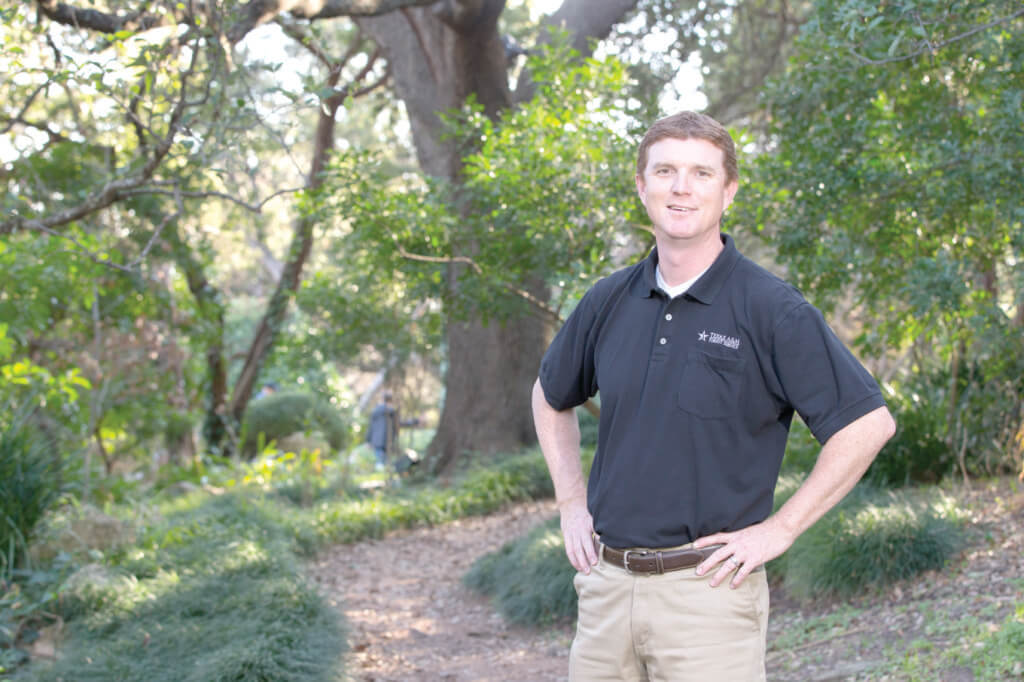
Clay Bales, forester with Texas A&M Forest Service, identified some 30 trees in Steiner Ranch that have oak wilt. “The rate of spread of the disease through the roots is approximately 75 feet per year,” Bales said.
By LYNETTE HAALAND, Four Points News
Oak wilt was recently confirmed in Steiner Ranch and managing the disease is difficult. Oak wilt spreads quickly, especially through tree roots, ultimately killing most trees that are susceptible.
“The rate of spread of the disease through the roots is approximately 75 feet per year,” said Clay Bales, Texas A&M Forest Service forester.
Once oak wilt infects an oak tree, the disease can spread through the roots to other oak trees. Out of all of the oak varieties, red oaks and live oaks are most susceptible to the disease.
Roots form a network underground which accelerates the rapid spread.
“Large live oaks can root-graft to other large live oaks up to 200 feet away,” Bales said.
A homeowner in Steiner called Texas A&M Forest Service about three months ago, suspecting they had oak wilt. Bales investigated the case and found the disease. He also looked at nearby home lots and found oak wilt affecting nine more lots in the Plateau neighborhood. At this point, some 30 trees are affected in the community.
Bales also confirmed an oak wilt center along Selma Hughes Park Road off of Quinlan Park Road.
The Texas A&M Forest Service is currently monitoring over 2,000 oak wilt centers in Travis and Hays Counties. They spot many of these areas by airplane.
Oak wilt kills trees and tree removal is expensive and removing trees can negatively affect property values in communities, Bales said. Additionally stopping the spread of oak wilt is expensive and, in many cases, takes an organized effort.
Stopping the spread
Combating live oak depends on the homeowners and the community and its approach and/or guidelines for it.
Bales has seen cases where homeowners have trenched on the edge of their property or all the way around their property to try to protect from a moving oak wilt center. He has seen cases where neighbors work together and trench around the oak wilt disease center.
“When establishing a trench, the goals are to go deep enough to sever roots and to go far enough away to make sure the trench is beyond the infected roots,” Bales said.
Texas A&M Forest Service recommends trenches at least 4 feet deep and at least 100 feet away from the nearest symptomatic trees.
“Optimally, the disease reaches the trench line in a few years and the trees die which results in the death of the oak wilt disease,” Bales said.
He has found that many communities have benefited from water lines or underground utility trenching which can stop the spread. Such trenches are often effective barriers to the movement of oak wilt across streets, especially if the trench was put in in the last 15 years, he said.
“Steiner Ranch has such trenches ranging in age from 20 years old to 5 years old,” Bales said. “The new oak wilt center in Steiner Ranch hasn’t crossed (John Simpson Trail) yet, and there is chance that the trenches, which may be nearing 20 years old, could be containing it for now,” Bales said.
Natural barriers such as cliffs or streams stop or slow down the spread of oak wilt.
Another way to fight oak wilt is by injecting a fungicide into all live oaks or high-valued live oaks, Bales said. Injecting trees with fungicide can help preserve the canopies of individual trees that would normally die from oak wilt.
“However, the disease will still move through the roots to neighboring trees,” Bales said. “It is not advised to inject trees that are further than 150 feet away from symptomatic oak wilt trees because these trees will put on new growth before the disease get there and then be unprotected.”
Other responses to oak wilt include keeping other trees in preparation for live oak losses and planting non-oaks ahead of the disease front for a replacement stand.
The Steiner Ranch HOA is hosting two oak wilt education presentations on July 14 and Aug. 3 at 6 p.m. at Towne Square Community Center with an expert who will share about identifying, preventing, and managing oak wilt.
